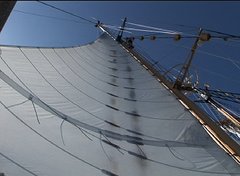The students handle this weather with ease now – their capacity to carry on scientific station work- measuring and pouring fluids to do nitrates, phosphates and nutrient or microscopic observations, sailing the ship, creating delicious galley meals, and being up at all hours to keep the vessel going by watch, from galley to deck is remarkable. Boris and I served all day yesterday in the galley, and this reaffirmed my awareness that this job is the hardest by far on the trip. Imagine cooking three meals and three snacks in a single day in a hot galley in a rolling sea. It is not easy, and the students do this every day with the guidance of our Steward Anna. At this point, the students of Stanford@SEA (S223 in SEA terms) are primarily taking charge in all aspects of the shipboard function.
The final phase of the trip has begun when each student is a JWO, which means a Junior Watch Officer. Here they will be completely in charge- with the true watch officers standing close by. JWOs provide leadership on the watch, calling out the commands for changing sails or helm orders, and JWO will be the communications point person with science deck.

The Tucker trawl being prepared for deployment
We’ve been studying the oxygen minimum layer intensively here in this portion of the Pacific. Its shoaled up to 100m in the past few casts. Oxygen is very low below 100m - perhaps becoming a biogeographic boundary for larger vertebrates. We’re using the Tucker trawl with 3 nets to sample the mesopelagic world that lies in this low oxygen zone and we’re finding some remarkable squid, hatchet fish and other very beautiful midwater animals capable of handling the harsh environs.

A silvery hatchetfish and a variety of bright red crustaceans come up in a midwater trawl
Alex and Nick have projects that will utilize the data sets being generated by the daily tows and intensive processing. Kate Lowry’s been working up the station data from the CTD and corresponding with our shore base support from NOAA (Dr. Dave Foley) for an in situ comparison of chlorophyll from the CTD and satellite data. Students are busy analyzing data for their individual projects and final oral reports and papers which are due early next week. The ship is a bee hive of activity and everywhere you go you see students with computers either discussing data or writing up their work.
The log shows we’re past 2500 nm on this trip- and we’re about 600 nm from Southpoint, Hawaii. That’s a lot of sailing in the Pacific, with a few hundred more miles to go before we see the mountainous volcanoes of the big island.
-Dr. Barbara Block


No comments:
Post a Comment